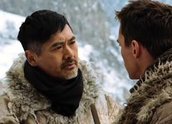


Children of the Silk Road (2007)
Synopsis
This large-scale period film is a love story set against the backdrop of the Japanese occupation of China in the years leading up to the Second World War. Young British journalist George Hogg (Jonathan Rhys Meyers) poses as a driver for the Red Cross so he can get to the Chinese capital of Nanking and report on the Japanese occupation. He witnesses troops massacre a big group of Chinese civilians, is captured, then helped to escape by Chinese freedom fighters, led by English-speaking Hansheng Chen (Chow Yun-Fat).
Hogg is later wounded and taken to a makeshift hospital where he is cared for by nurse Lee Pearson (Radha Mitchell). He wants to return to the front with Chen but, knowing he will be a liability, Chen encourages him to travel to Huang Shi, where he can safely recuperate. On arrival Hogg finds 60 hungry, wild boys, whom he helps escape from the Japanese along the famous silk road.
Curator’s notes
The dramatic starting point for the narrative is an incident, based on the actual Nanking Massacre of early 1938, that Hogg witnesses (see clip one). What subsequently happens to Hogg in the film is inspired by a real-life rugby-playing Oxford graduate who was in China during the Second Sino-Japanese War.
The film’s story has been told often on the big screen – a Westerner gets caught up in a significant world conflict in a foreign land – and this and the epic nature of the storytelling gives the film an old-fashioned feel. The presence of two of China’s best known actors, the charismatic Chow Yun-Fat and the beautiful Michelle Yeoh, boosts the film’s appeal to international audiences.
Although based on Hogg’s life, some artistic licence taken by the filmmakers has drawn criticism: the real Hogg only assisted the 60 orphans to escape from the Japanese while the main instigator of the escape in real life (Rewi Alley) was written out of the script completely. Another variation from reality is that the nurse (Radha Mitchell) was a New Zealander, but is here portrayed as American.
It is rare for a film of this scale to call itself Australian but it can by dint of being an official co-production with Germany and China. In fact, it is Australia’s first official co-production with China. The Australian elements include producer Jonathan Shteinman, composer David Hirschfelder and production designer Steven Jones-Evans, the internationally-known actors Radha Mitchell and David Wenham, and Guang Li, a Melbourne schoolboy who was cast as Shi-Kai.
Official co-productions get national status in each of the participating countries, and that makes them eligible for government subsidies and other advantages. The film was not subject to the restrictions China places on many overseas films, for example. Co-production arrangements can give Australian producers more access to the resources needed to tell big stories with star power, increasing their chance of successfully competing with major Hollywood fare. Chinese films of a large scale are often edited and post-produced in Australia, examples being Hero (2002) and House of Flying Daggers (2004).
Children of the Silk Road was released in Australian cinemas on 3 July 2008. It received AFI award nominations in 2008 for Costume Design and Production Design.
- Overview
- Curator’s notes
- Video 3 clips
- Principal credits
- Find a copy
- Make a comment
- Map
- Add your review



